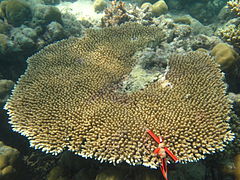| Acropora hyacinthus | |
|---|---|

| |
| Lodestone Reef, Queensland | |
| Conservation status | |
 Near Threatened (IUCN 3.1) | |
| Scientific classification | |
| Domain: | Eukaryota |
| Kingdom: | Animalia |
| Phylum: | Cnidaria |
| Class: | Hexacorallia |
| Order: | Scleractinia |
| Family: | Acroporidae |
| Genus: | Acropora |
| Species: | A. hyacinthus |
| Binomial name | |
| Acropora hyacinthus (Dana, 1846) | |
| Synonyms | |
List
| |
Acropora hyacinthus is a species of Acropora described from a specimen collected in Fiji by James Dwight Dana in 1846. It is thought to have a range that includes the Indian Ocean, the Indo-Pacific waters, southeast Asia, Japan, the East China Sea and the western Pacific Ocean. It lives on shallow reefs on upper reef slopes, and is found from depths of 1–25 metres (3.3–82.0 ft). Crown-of-thorns starfish preferentially prey upon Acropora corals.
Description
Acropora hyacinthus occurs in plate- or table-shaped wide colonies that consist of a number of thin branches in a lattice structure. It has strongly inclined branchlets. A. hyacinthus has axial dominant branches, so each branch has a large dominant axial corallite with much smaller cup-shaped radial corallites. The corallites on specimens of A. hyacinthus are often darker than the main branch structure. The species looks similar to many tabular Acropora species and is often misidentified in the field.
Growth rate
Branching corals of the genus Acropora are among the fastest-growing taxa on most coral reefs. A. hyacinthus has an average growth rate that ranges from 3–10 centimetres (1.2–3.9 in) diameter increase per year, with much of this variation thought to be a response to temperature, in addition to competition and other abiotic and biotic factors.
Distribution
Like most corals, Acropora hyacinthus is classed as a data deficient species on the IUCN Red List, but it is believed that its population is decreasing in line with the global decline in reefs, and it is listed under Appendix II of CITES. Figures of its population are unknown, but is likely to be threatened by the global reduction of coral reefs, the increase of temperature causing coral bleaching, climate change, human activity, the crown-of-thorns starfish (Acanthaster planci) and disease. It occurs at depths from 1 to 25 metres (3 ft 3 in to 82 ft 0 in) on the upper slopes of shallow reefs. It occurs in the Indian Ocean, the Indo-Pacific waters, southeast Asia, Japan, the East China Sea, Australia, and the western Pacific Ocean.
Taxonomy
The species was originally described by James Dwight Dana in 1846 as Madrepora hyacinthus. Currently this species is considered to be a species complex, with many of the synonyms being called into question.
References
- ^ Aeby, G.; Lovell, E.; Richards, Z.; Delbeek, J.C.; Reboton, C.; Bass, D. (2008). "Acropora hyacinthus". IUCN Red List of Threatened Species. 2008: e.T133479A3765052. doi:10.2305/IUCN.UK.2008.RLTS.T133479A3765052.en. Retrieved 19 November 2021.
- "Invertebrate Zoology Collections Search". collections.nmnh.si.edu. Retrieved 2021-11-16.
- Tomascik, T.; van Woesik, R.; Mah, A. J. (1996-09-01). "Rapid coral colonization of a recent lava flow following a volcanic eruption, Banda Islands, Indonesia". Coral Reefs. 15 (3): 169–175. doi:10.1007/BF01145887. ISSN 1432-0975.
- Wakeford, M.; Done, T. J.; Johnson, C. R. (2008). "Decadal trends in a coral community and evidence of changed disturbance regime". Coral Reefs. 27 (1): 1–13. ISSN 0722-4028.
- Linares, C; Pratchett, Ms; Coker, Dj (2011-10-05). "Recolonisation of Acropora hyacinthus following climate-induced coral bleaching on the Great Barrier Reef". Marine Ecology Progress Series. 438: 97–104. doi:10.3354/meps09272. ISSN 0171-8630.
- "Acropora hyacinthus (Dana, 1846)". World Register of Marine Species. Retrieved 5 September 2018.
- "Collecting topotypes of all nominal species". Project Phoenix. 2020-09-02. Retrieved 2021-11-16.


